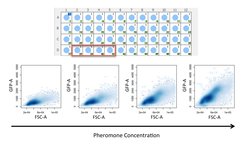Flow Cytometry
Flow cytometry allows the simultaneous measurement of different fluorescence channels in single cells, reporting the cellular concentration of fluorescently-tagged molecules, and other physical or biological parameters, such as cell size or granularity. Thousands of cells per second can be measured, making the approach statistically robust. Flow cytometry measurements are performed on a BD Fortessa with laser lines optimized for excitation of fluorescent proteins. The instrument is equipped with a high-throughput sampler device dedicated to multi-well plates. The measurement of 96 samples can take as low as 15 minutes. Users, after appropriate training, can use this instrument independently. Fluorescence activated cell sorting (FACS) allows to physically sort cells populations based on their fluorescence properties and/or on their size. The core facility is equipped with a BD FACSAria Fusion, allowing complex multi-color sorting. This instrument needs to be operated by experienced staff. Both the BD Fortessa and FACSAria Fusion are highly sensitive gel-coupled cuvette instruments. They are able to identify and sort populations with low-fluorescence, making them particularly suitable for experiments performed on bacteria.

Equipment
BD Fortessa Flow Cytometer
Laser lines: 445 nm, 488 nm, 514 nm, 561 nm. 13 fluorescence channels and high-throughput sampler (for measurements in multi-well plates)
BD FACSAria Fusion
Laser lines: 355 nm, 445/488 nm, 561 nm, 633 nm. 18 fluorescence channels. 2 or 4 way sorting. Single cell sorting into multi-well plates.
Applications
- Measurements of single-cell gene expression in populations, including analysis of gene expression noise
- Measurements of dose-dependent activation of transcriptional reporters in multi-well plates
- Cell cycle studies in prokaryotic and eukaryotic microorganisms
- Cell Sorting
